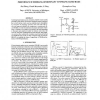Free Online Productivity Tools
i2Speak
i2Symbol
i2OCR
iTex2Img
iWeb2Print
iWeb2Shot
i2Type
iPdf2Split
iPdf2Merge
i2Bopomofo
i2Arabic
i2Style
i2Image
i2PDF
iLatex2Rtf
Sci2ools
ISCAS
2003
IEEE
2003
IEEE
Performance modeling of resonant tunneling based RAMs
Tunneling based random-access memories (TRAM’s) have recently garnered a great amount of interests among the memory designers due to their intrinsic merits such as reduced power consumption by elimination of refreshing operation, faster read and write cycles, and improved reliability in comparison to conventional silicon DRAM’s. In order to understand the precise principle of operation of TRAM’s, an in-depth circuit analysis has been attempted in this paper and analytical models for memory cycle time, soft error rate, and power consumption have been derived. The analytical results are then validated by simulation experiments performed with HSPICE. These results are then compared with conventional DRAM’s to establish the claim of superiority of TRAM performance to DRAM performance.
Related Content
| Added | 04 Jul 2010 |
| Updated | 04 Jul 2010 |
| Type | Conference |
| Year | 2003 |
| Where | ISCAS |
| Authors | Hui Zhang, Pinaki Mazumder, Li Ding 0002, Kyounghoon Yang |
Comments (0)

